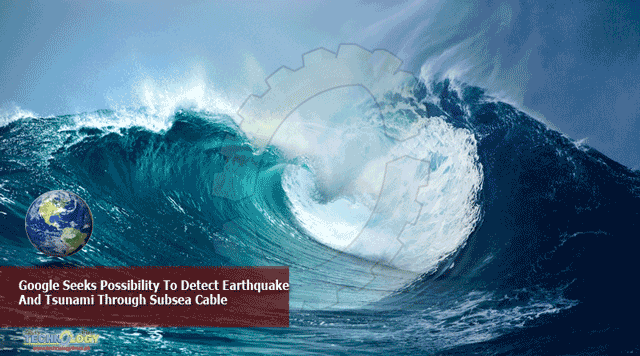Google LLC has been exploring the possibility of using its network of undersea cables to try to detect earthquake as they happen in real time, with the goal of providing a better early warning system for communities threatened by tsunami.

In a blog post today, Google’s global networking engineers Valey Kamalov and Mattia Cantono explained that the company operates an extensive system of fiber optic subsea cables that stretch for thousands of kilometers across the seabed.
Those cables carry data as pulses of light traveling at 204,190 kilometers per second, making it possible to send and receive information around the world at the speed of light. But they can also be used to monitor the ocean floor for “mechanical disturbances” that could indicate an earthquake is taking place.
Google knows when disturbances take place because the pulsing light that travels through its subsea cables typically encounters distortions that must be corrected through digital signal processing once they arrive at their destination.
“One of the properties of light that is tracked as part of the optical transmission is the state of polarization (SOP),” Kamalov and Cantono wrote. “The SOP changes in response to mechanical disturbances along the cable and tracking these disturbances enables us to detect seismic activity.”
The basic premise is that when an earthquake happens, Google’s undersea cables can pick up the vibrations as the ground shakes underneath them. And Google has already proven the accuracy of this theory. In 2019 it began monitoring the SOP on some of its subsea cables as an experiment, and observed that the ocean floor is “remarkably stable” for most of the time.
But after several months of watching and waiting, something happened.
“On January 28, 2020, we detected a magnitude 7.7 earthquake off of Jamaica—1500 km away from the closest point of one of our cables!” the Google engineers wrote. “A plot of SOP over time showed a pronounced spike at a time stamp approximately five minutes after the earthquake occurred, correlating to the travel time of the seismic wave from Jamaica to the cable, and the duration of the spike was about 10 minutes.”
Google kept on watching, and detected two more earthquakes. On March 22, it identified a magnitude 6.1 earthquake on the East Pacific Rise, which is a mid-oceanic ridge located on the floor of the Pacific Ocean, about 2,000 kilometers from one of its cables. Then on March 28 it detected another, 4.5 magnitude quake off the coast of Valparaiso, Chile, which was just 30 kilometers away from one of its cables.
“The event produced a clear but short spike of SOP activity — the short duration was likely to due to a rapid decay in the vibration intensity along the cable for this relatively small event,” Kamalov and Cantono said.
Google shared its findings with Zhongwen Zhan of the California Institute of Technology Seismological Laboratory, who realized that the data could also be used to detect pressure changes in the ocean itself. In turn, that can be used to predict the likelihood of a tsunami emerging as a result of an earthquake.
That’s an exciting discovery, because most tsunami early warning systems are not very effective. The problem is that most of that equipment is located onshore, or scattered across the ocean. Onshore equipment doesn’t really provide enough time to carry out an evacuation, and offshore detection systems are limited because of the speed of the tsunami, which can be as much as 800 kilometers per hour.
But if one of Google’s subsea cables runs near the epicenter of an earthquake, it could theoretically communicate a warning at the speed of light, which means that those in the tsunamis’ path would be given enough time to evacuate. Another advantage of Google’s proposed system is that the infrastructure is already in place, since millions of kilometers of fiber optic networks already span the ocean floor.
Of course, Google said there’s still a long way to go before anyone creates a properly working system that people can rely on, but it’s still excited by the potential.
“We see this approach not as a replacement of dedicated seismic sensors but as a source of complementary information to enable early warnings for earthquakes and tsunami,” Kamalov and Cantono said.
Show your support for our mission with our one-click subscription to our YouTube channel (below). The more subscribers we have, the more YouTube will suggest relevant enterprise and emerging technology content to you. Thanks!
… We’d also like to tell you about our mission and how you can help us fulfill it. SiliconANGLE Media Inc.’s business model is based on the intrinsic value of the content, not advertising. Unlike many online publications, we don’t have a paywall or run banner advertising, because we want to keep our journalism open, without influence or the need to chase traffic.The journalism, reporting and commentary on SiliconANGLE — along with live, unscripted video from our Silicon Valley studio and globe-trotting video teams at theCUBE — take a lot of hard work, time and money. Keeping the quality high requires the support of sponsors who are aligned with our vision of ad-free journalism content.
Originally posted at : siliconangle
